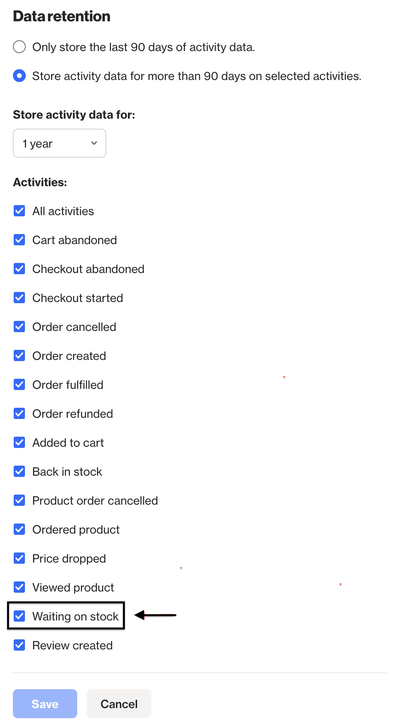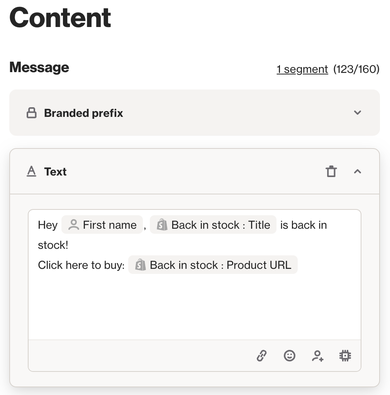Using ecommerce stock activities
When connecting Ortto to an e-commerce data source, the Waiting on stock and Back in stock activities are enabled in your customer data platform (CDP). These activities are associated with a contact when the contact requests to be notified (such as via a widget on your store’s website) when an item is back in stock.
To get started, add a back in stock reminder capture widget to your website using Ortto’s template for Shopify (also available for other e-commerce integrations). When customers submit their details using the widget, they become associated with a Waiting on stock activity. Then, when your item is restocked, this triggers a Back in stock activity to be associated with the people waiting on it. You can then use these activities to trigger journeys and/or use the activities as criteria for campaign audiences to send stock notification messages.
NOTE:
- The Back in stock activity is automatically created and associated with relevant contacts when the item inventory value changes from
0to at least1. - For example, if you have a playbook set to send a notification to customers when Back in stock occurs, as soon as Ortto receives the data from Shopify, a Back in stock activity will be associated with the relevant contacts and the playbook will begin sending.
For Waiting on stock, there is a default data retention period of 90 days. However, if you select to enable a longer data retention period for the e-commerce data source, and have Waiting on stock selected as an activity for which to extend data retention, you can access as much data as is available for the data source’s retention period.
Extending the data retention period for Waiting on stock is important if you have a product which is seasonal or takes a bit longer to become available again. If the Waiting on stock data ages out of the default 90 day period, then Back in stock cannot be associated with the people who were waiting on it for more than 90 days. Learn more about Configuring data retention.

Add stock activities to campaigns
You can notify customers about stock activities in a number of ways.
Initially, set up a journey to send a confirmation that you will notify the customer when an item is back in stock. For the People enter when criteria, choose Waiting on stock occurs then add email and/or SMS messages that tell the customer that you will notify them when the item is back in stock.
When the item is restocked, create a journey or playbook:
- For the People enter when criteria, choose Back in stock occurs.
- Then add an email shape/message to notify the customer the item is back in stock.
- In the email shape/message, add the Back in stock widget to the email message body. This widget will show the recipient the most recently restocked item they were waiting on. To add this widget:
- On the Content page when creating an email message, locate the Back in stock widget in the right-hand panel, under Content.
- Click and drag the widget to add it to your email message.
- Click Configure to setup the widget as required, then click Save to finish.

NOTE: Only email messages can be configured with the back in stock widget — it is not available to insert into SMS messages or push notifications.
You can also create back in stock notifications for email and SMS campaigns, and push notifications. However, your recipients for the email, SMS or push campaign will not be able to be based on the Back in stock occurs activity condition, as occurs is only available for journeys and playbooks. Instead, you’ll need to use an activity condition like Back in stock has occurred with a When clause such as in the last 7 days to capture people who have recently been associated with the activity. Adding the When clause will help you manage which customers with a Back in stock activity are notified, to ensure you don’t double-up by sending a notification to someone who has already been contacted about the restock.

For SMS messages and push notifications, you can use merge tags to populate the restocked item’s details, such as it’s title and URL.

TIP:
- Add a Where clause to Back in stock occurs in People enter when to further customize the stock notification campaign (e.g.
Back in stock occurs where SKU is 1234orBack in stock occurs where data source is My Shop). - If needed, you can build in a buffer between a Back in stock activity occurring and notification messages sending. This will give you some time to edit or turn off the campaign if you’re not quite ready to notify customers about a product restock.To do so, create a journey with Back in stock occurs as the entry criteria. Then, add a Delay as the first journey shape before any notification messages.
